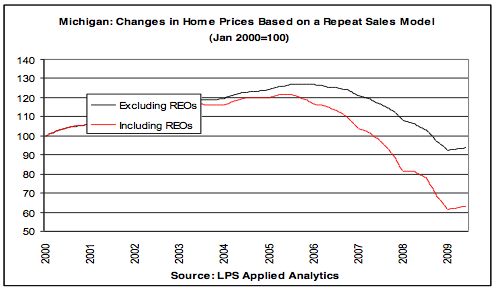Foreclosures are accounting for a large drop in housing prices according to a study by Lender Processing Services. The study compared prices achieved by organic sales and then factored in the lower priced REO sales. For more on this, see the following article from HousingWire.
As the US unemployment rate rises to 9.7% in August, pressuring US consumers at a time when the foreclosure pipeline remains clogged, Lender Processing Services (LPS: 34.28 -2.06%) is drawing an important link between sales of foreclosed, real estate-owned (REO) houses and falling house prices.
“REO sales account for as much as 60% of housing activity in some states,” said Nima Nattagh, senior vice president at LPS Applied Analytics. “Our study contains specific data to show this is causing precipitous drops in home values.”
Fewer homes are selling in the first half of 2009 compared with previous-year data in many states, yet the share of REO sales in some cases doubled, according to LPS’ data.
The Northeast and Northwest regions appear to have been sheltered somewhat more than hard-hit areas like the West and Midwest, where general economic downturn compounded poor performance of subprime and other exotic mortgage products to push mortgage delinquencies to an all-time high.
“While REO sales activity has increased significantly across all regions in the country, there is clearly a dichotomy between states that have seen unprecedented levels of mortgage delinquency and those where the impact of the current housing crisis has been much more moderate,” Nattagh said.
In Michigan, where REO sales account for 64% of home sales so far in 2009, a break down of home prices shows a disparity between the price achieved through organic — or non-distressed — sales and the significantly lower price seen when REO sales are factored in.

According to the chart above, Michigan prices excluding REO sales have dropped by more than 26% since their peak in 2005, and seem in the last several months to be edging back up toward levels seen in January 2000 (the baseline for the current LPS study). But when REO sales are factored in, prices are significantly lower, holding 47% below the high.
“This study clearly shows that when foreclosure levels are high and REO sales dominate the majority of transactions, their impact on the rest of the market should be taken into account accordingly,” Nattagh said.
The data arrives as the US Bureau of Labor Statistics indicates the US unemployment rate rose to 9.7% in August. Recent market analysis makes a connection between rising unemployment and spiking mortgage delinquency. As more loans roll into the foreclosure process, high unemployment may play a significant role in keeping the foreclosure pipeline clogged.
This article has been republished from HousingWire. You can also view this article at HousingWire, a mortgage and real estate news site.
Related Posts
- Homebuyers can’t get a break as mortgage rates march back toward 7%
- Home prices could jump 5% in the next 12 months as high mortgage rates freeze the housing market, Zillow economists say
- The US housing market is set to cool this fall, setting up a rare opportunity for buyers as sellers slash prices, Zillow says
- We’re entering a brutal new era for the housing market
- Homeowners Are Increasingly Reluctant to Sell, But Not For The Reason You’d Expect
- Housing market predictions: The forecast for the next 5 years
- Homebuyers are ‘losing patience,’ no longer on the sidelines: survey